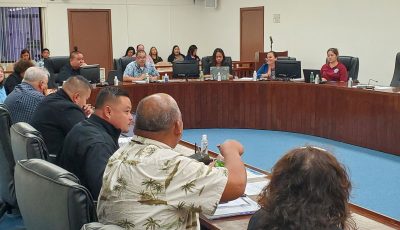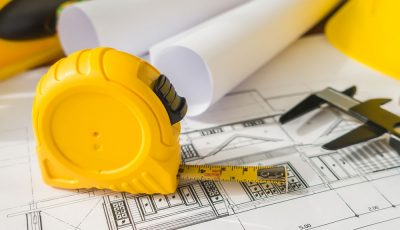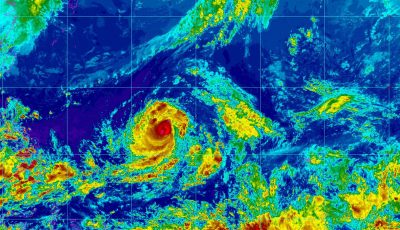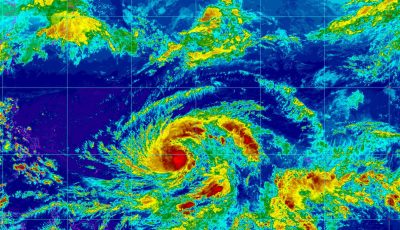PSS has 1st day of blended classes
The Public School System kicked off the month of February by welcoming back students on campus, with all schools participating in blended learning—a mix of in-person classes and online instruction.
In an interview with Gregorio T. Camacho Elementary School principal Raena Camacho, GTC welcomed back only half of their students to the campus—approximately 167 students—while the other half attended online classes. GTC has a total of 335 enrolled students.
Camacho said that GTC started preparing for in-person learning last summer. “…Actually, for half of our student population, it’s not something new because we’ve been implementing the intervention sessions since October, so half of our kids have been here, [while] for the other half, this this is basically their first day of school here on campus,” said Camacho.
Because elementary schools are more into collaborative learning, or group work, Camacho stated that some of the adjustments they had to make were setting up dividers, and putting desks 6 feet apart, to make sure that GTC meets the social distancing requirement. GTC also has a temperature reading, along with sanitizers everywhere.
Camacho said that it has been a little trickier with children because they have to think about how to ensure the 6-foot requirement for lunch and recess. “We don’t allow [eating] in the cafeteria, unless we can, of course, accommodate the spacing. …From what I know, all elementary schools, at least with us here, the students are eating in their classrooms,” said Camacho.
As for recess, because it’s only a 10-minute recess, Camacho stated that they staggered their recess period at 10 minutes each and divided the children into groups. “We have one group recess and we kind of split our field into areas so that all the groups remain with their group and are not having any crowding anywhere,” she said.
Tanapag Middle School
As for middle school, Tanapag Middle School principal Hilda Rios stated that they welcomed back approximately 150 students yesterday, while the other half are online. TMS has about 305 students in all.
Back then, when face-to-face classes were only for students who needed it, TMS could only accommodate 10 students in the classroom. This time, Rios said, they can accommodate 10 to 13 students in each classroom.
Just like elementary schools, TMS has been preparing for the resumption of face-to-face classes since last summer. “We’ve been preparing for this slowly but surely. We have to make sure that all our safety measures are in place, our protocols are in place. We have to look at our population, our number of kids, first, so that we know how many students we can put into classrooms if we do have that space,” said Rios.
Rios added that all protocols, such as wearing of face masks, social distancing, and temperature checks are in place. Because wearing a mask can be harder for children, Rios allowed her teachers to give students a break when they need to “take a breather.”
“Face masks are definitely worn throughout the day. I do allow my teachers to give some flexibility for students to walk out of the classroom sometimes if they’re having a hard time with their mask on because having this on an entire day can be very difficult. So students are allowed to ask their teachers to take a step out and just kind of just take a breather, count to 30 seconds or so, then go back in and proceed with class. Those are some of the flexibility we allow,” said Rios. Only one student at a time can go out of the classroom.
As for the temperature checks, Rios said each student is checked before entering the classroom. If a student’s temperature is over 100º, the student is sent to the school office where their temperature will be double-checked. If it’s good, the student returns to class; if not, they will be isolated.
“Anytime a student is shown to have a temperature that is higher than 100º, they go to the office [and] we double-check their temperature. If it’s just a misreading of the temperature, we send them back to the classroom. Otherwise, we have an isolation room where we put kids and go through the process,” said Rios.
Student statements about blended learning
With the consent of parents, Saipan Tribune was able to talk to students in Kindergarten and the eighth grade.
Marlaina Benjamin, a fifth-grader and GTC’s student body president, said she’s happy to be back in school with her classmates, adding that it was hard to focus during virtual learning because there’s a lot of distractions.
“It’s really a challenge, because there’s a lot going on around you can’t really focus because you’re not in school and you’re at home,” said Benjamin. She overcame these challenges by talking with her classmates and having virtual meetings with the other members in the student body club.
Benjamin added that it makes her happy to see her classmates because she can see them in person, whereas virtually, she can’t see anyone due to their camera and microphones being off.
Reef Sablan, a GTC kindergartener, said he was happy to see everyone back in school on his first day on campus. Mae, another GT kindergartener, was also pleased to see all her friends.
Haane Salas, a TMS eighth grader, stated that quarantined made her introverted and unsociable. “My time in quarantine I’ve honestly become introverted, but once I came back, I was like, you know, this is, this is actually pretty nice. It’s nice to be around people again, so I liked it,” said Salas.
Salas stated that the hardest thing about face-to-face classes is that she can’t be in physical contact with her close friends. “One of the hardest parts about it, about being in this situation, is literally not being able to touch people. Like my best friend, she’s 6 feet apart from me, and I could not hug her, I just have to stare at her, I could just say hi, but I cannot hug or touch her, and that is really hard for me,” said Salas.
Another TMS eighth-grader, Ernie Teigta, says that while he does not like being physically in class, he still thinks that face-to-face classes make “life much easier.”
Both Salas and Teigta confirmed that they got their temperatures checked prior to going into class.
Education Commissioner Dr. Alfred B. Ada said in a previous interview that the safest way to welcome back students is to have blended learning as part of their “step closer to normalcy.”



























